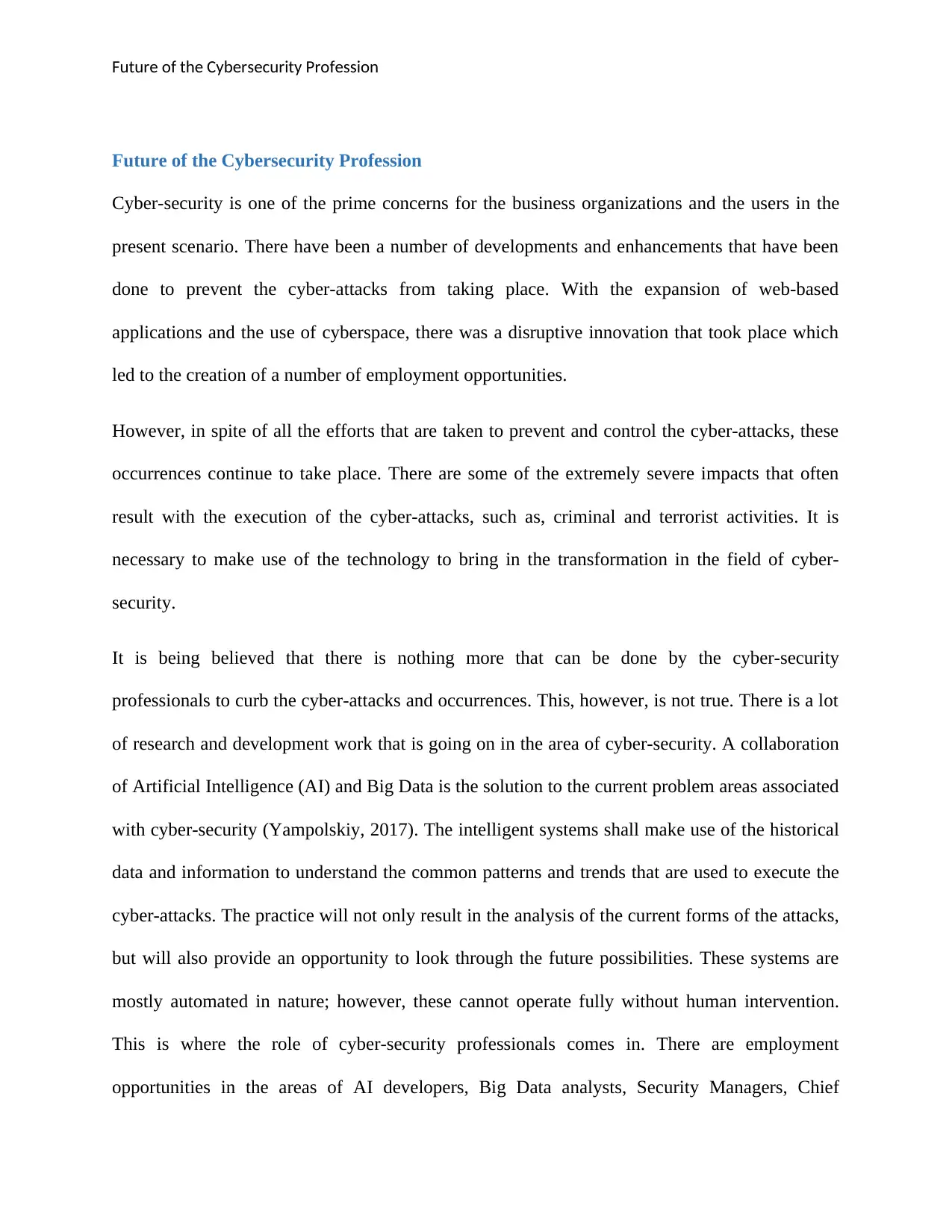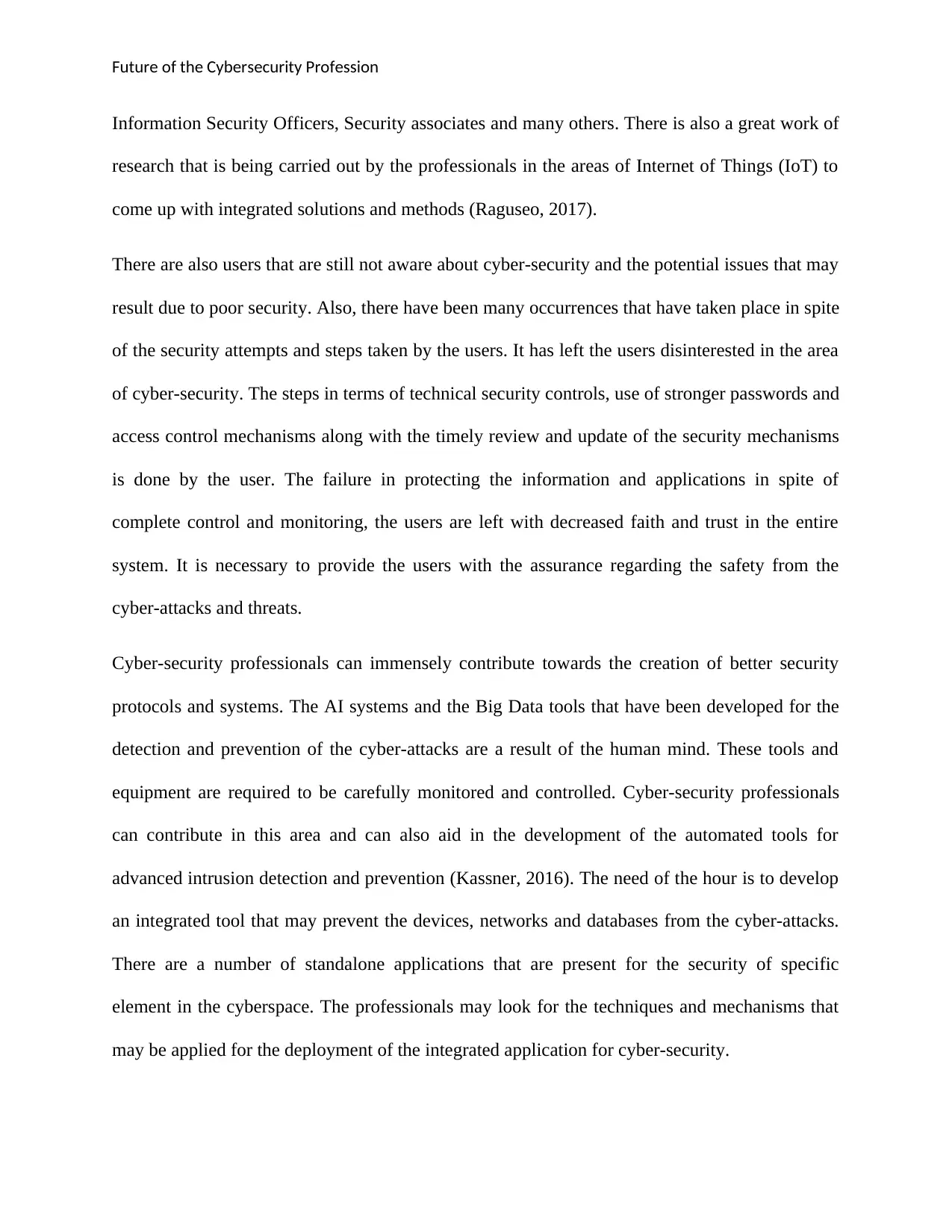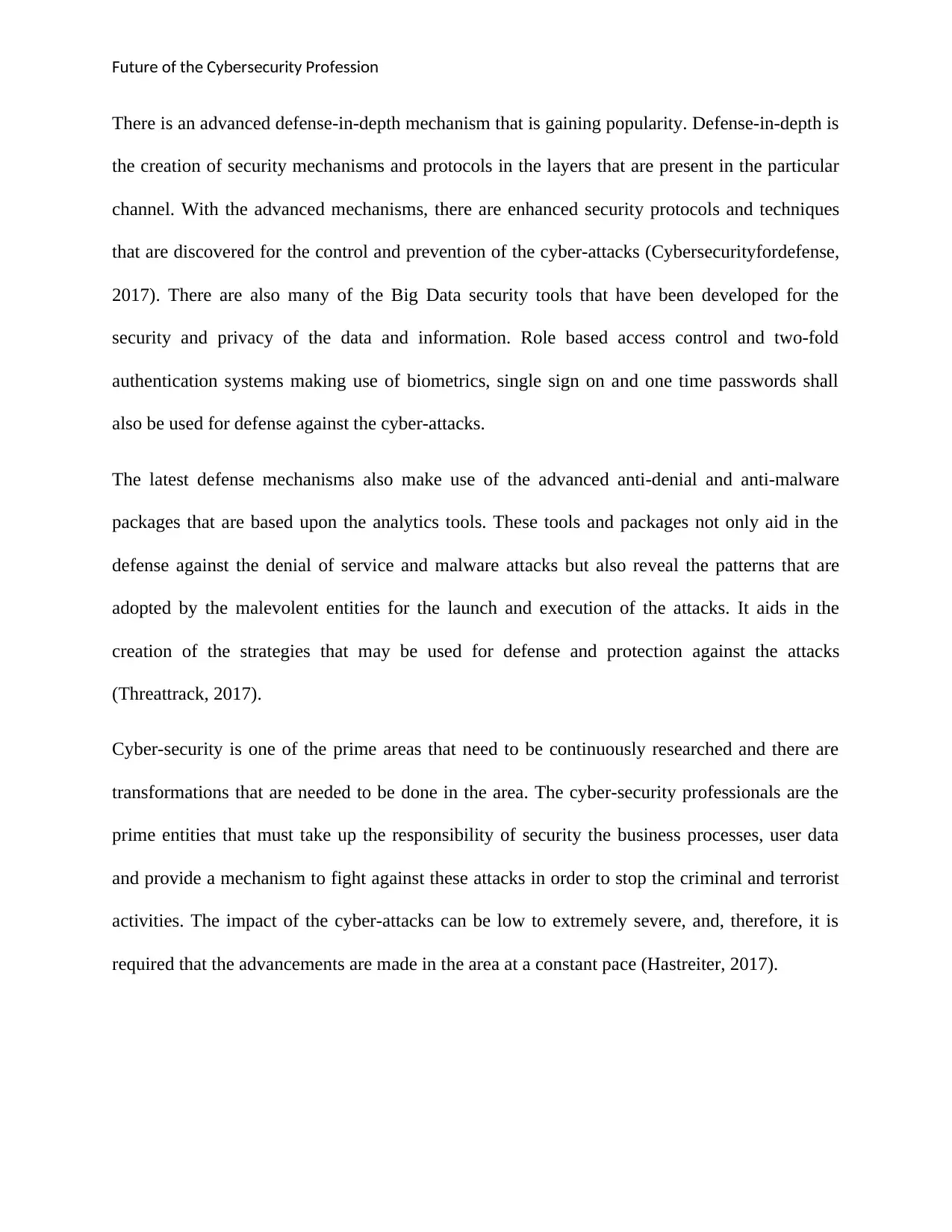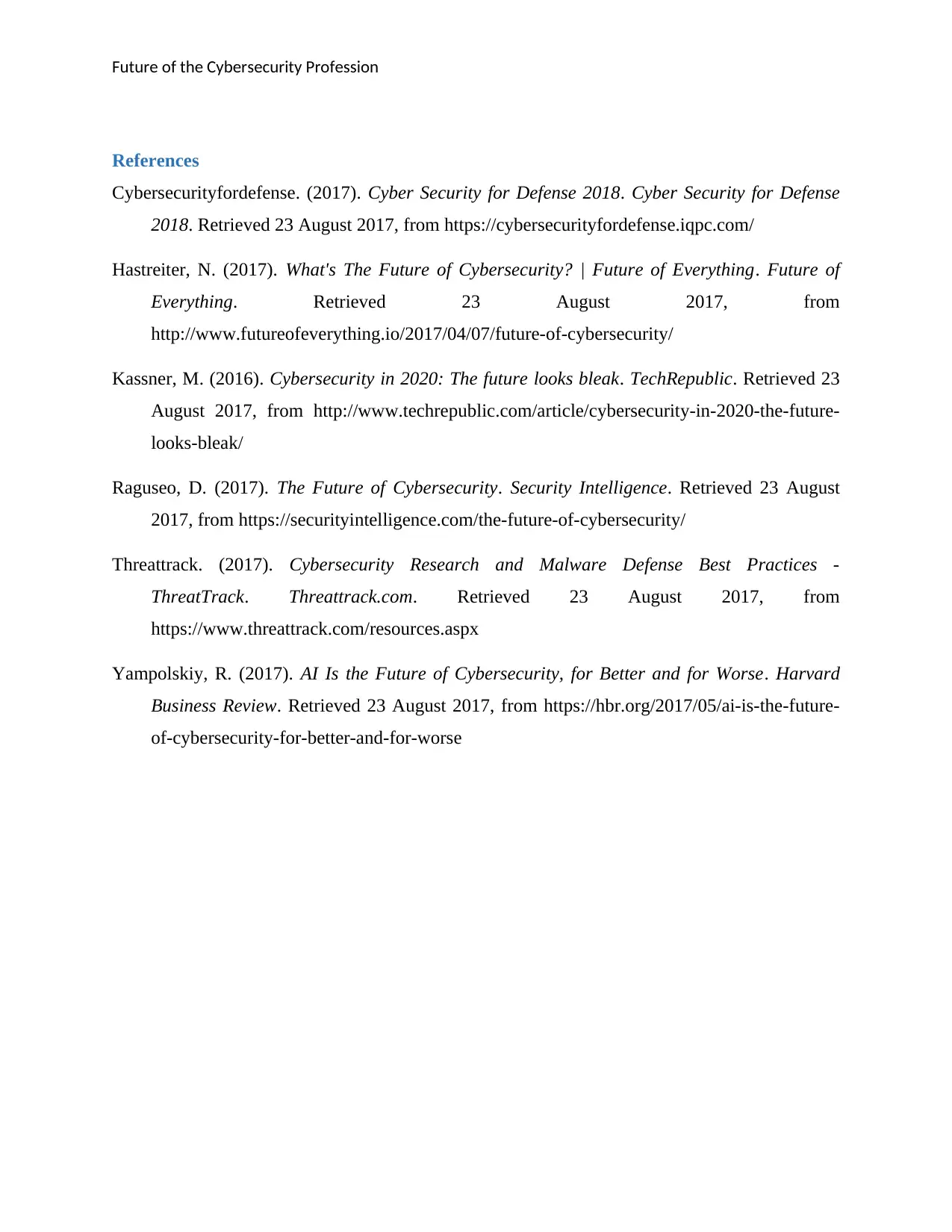The Future of the Cybersecurity Profession: An In-depth Report
VerifiedAdded on 2020/03/13
|6
|1177
|32
Report
AI Summary
This report delves into the future of the cybersecurity profession, emphasizing the critical role of professionals in an era increasingly shaped by cyber threats. It highlights the integration of Artificial Intelligence (AI) and Big Data as key solutions for analyzing and preventing cyber-attacks, moving...

Future of the Cybersecurity Profession
Article
8/23/2017
Article
8/23/2017
Paraphrase This Document
Need a fresh take? Get an instant paraphrase of this document with our AI Paraphraser

Future of the Cybersecurity Profession
Table of Contents
Future of the Cybersecurity Profession........................................................................................................3
References...................................................................................................................................................6
Table of Contents
Future of the Cybersecurity Profession........................................................................................................3
References...................................................................................................................................................6

Future of the Cybersecurity Profession
Future of the Cybersecurity Profession
Cyber-security is one of the prime concerns for the business organizations and the users in the
present scenario. There have been a number of developments and enhancements that have been
done to prevent the cyber-attacks from taking place. With the expansion of web-based
applications and the use of cyberspace, there was a disruptive innovation that took place which
led to the creation of a number of employment opportunities.
However, in spite of all the efforts that are taken to prevent and control the cyber-attacks, these
occurrences continue to take place. There are some of the extremely severe impacts that often
result with the execution of the cyber-attacks, such as, criminal and terrorist activities. It is
necessary to make use of the technology to bring in the transformation in the field of cyber-
security.
It is being believed that there is nothing more that can be done by the cyber-security
professionals to curb the cyber-attacks and occurrences. This, however, is not true. There is a lot
of research and development work that is going on in the area of cyber-security. A collaboration
of Artificial Intelligence (AI) and Big Data is the solution to the current problem areas associated
with cyber-security (Yampolskiy, 2017). The intelligent systems shall make use of the historical
data and information to understand the common patterns and trends that are used to execute the
cyber-attacks. The practice will not only result in the analysis of the current forms of the attacks,
but will also provide an opportunity to look through the future possibilities. These systems are
mostly automated in nature; however, these cannot operate fully without human intervention.
This is where the role of cyber-security professionals comes in. There are employment
opportunities in the areas of AI developers, Big Data analysts, Security Managers, Chief
Future of the Cybersecurity Profession
Cyber-security is one of the prime concerns for the business organizations and the users in the
present scenario. There have been a number of developments and enhancements that have been
done to prevent the cyber-attacks from taking place. With the expansion of web-based
applications and the use of cyberspace, there was a disruptive innovation that took place which
led to the creation of a number of employment opportunities.
However, in spite of all the efforts that are taken to prevent and control the cyber-attacks, these
occurrences continue to take place. There are some of the extremely severe impacts that often
result with the execution of the cyber-attacks, such as, criminal and terrorist activities. It is
necessary to make use of the technology to bring in the transformation in the field of cyber-
security.
It is being believed that there is nothing more that can be done by the cyber-security
professionals to curb the cyber-attacks and occurrences. This, however, is not true. There is a lot
of research and development work that is going on in the area of cyber-security. A collaboration
of Artificial Intelligence (AI) and Big Data is the solution to the current problem areas associated
with cyber-security (Yampolskiy, 2017). The intelligent systems shall make use of the historical
data and information to understand the common patterns and trends that are used to execute the
cyber-attacks. The practice will not only result in the analysis of the current forms of the attacks,
but will also provide an opportunity to look through the future possibilities. These systems are
mostly automated in nature; however, these cannot operate fully without human intervention.
This is where the role of cyber-security professionals comes in. There are employment
opportunities in the areas of AI developers, Big Data analysts, Security Managers, Chief
⊘ This is a preview!⊘
Do you want full access?
Subscribe today to unlock all pages.

Trusted by 1+ million students worldwide

Future of the Cybersecurity Profession
Information Security Officers, Security associates and many others. There is also a great work of
research that is being carried out by the professionals in the areas of Internet of Things (IoT) to
come up with integrated solutions and methods (Raguseo, 2017).
There are also users that are still not aware about cyber-security and the potential issues that may
result due to poor security. Also, there have been many occurrences that have taken place in spite
of the security attempts and steps taken by the users. It has left the users disinterested in the area
of cyber-security. The steps in terms of technical security controls, use of stronger passwords and
access control mechanisms along with the timely review and update of the security mechanisms
is done by the user. The failure in protecting the information and applications in spite of
complete control and monitoring, the users are left with decreased faith and trust in the entire
system. It is necessary to provide the users with the assurance regarding the safety from the
cyber-attacks and threats.
Cyber-security professionals can immensely contribute towards the creation of better security
protocols and systems. The AI systems and the Big Data tools that have been developed for the
detection and prevention of the cyber-attacks are a result of the human mind. These tools and
equipment are required to be carefully monitored and controlled. Cyber-security professionals
can contribute in this area and can also aid in the development of the automated tools for
advanced intrusion detection and prevention (Kassner, 2016). The need of the hour is to develop
an integrated tool that may prevent the devices, networks and databases from the cyber-attacks.
There are a number of standalone applications that are present for the security of specific
element in the cyberspace. The professionals may look for the techniques and mechanisms that
may be applied for the deployment of the integrated application for cyber-security.
Information Security Officers, Security associates and many others. There is also a great work of
research that is being carried out by the professionals in the areas of Internet of Things (IoT) to
come up with integrated solutions and methods (Raguseo, 2017).
There are also users that are still not aware about cyber-security and the potential issues that may
result due to poor security. Also, there have been many occurrences that have taken place in spite
of the security attempts and steps taken by the users. It has left the users disinterested in the area
of cyber-security. The steps in terms of technical security controls, use of stronger passwords and
access control mechanisms along with the timely review and update of the security mechanisms
is done by the user. The failure in protecting the information and applications in spite of
complete control and monitoring, the users are left with decreased faith and trust in the entire
system. It is necessary to provide the users with the assurance regarding the safety from the
cyber-attacks and threats.
Cyber-security professionals can immensely contribute towards the creation of better security
protocols and systems. The AI systems and the Big Data tools that have been developed for the
detection and prevention of the cyber-attacks are a result of the human mind. These tools and
equipment are required to be carefully monitored and controlled. Cyber-security professionals
can contribute in this area and can also aid in the development of the automated tools for
advanced intrusion detection and prevention (Kassner, 2016). The need of the hour is to develop
an integrated tool that may prevent the devices, networks and databases from the cyber-attacks.
There are a number of standalone applications that are present for the security of specific
element in the cyberspace. The professionals may look for the techniques and mechanisms that
may be applied for the deployment of the integrated application for cyber-security.
Paraphrase This Document
Need a fresh take? Get an instant paraphrase of this document with our AI Paraphraser

Future of the Cybersecurity Profession
There is an advanced defense-in-depth mechanism that is gaining popularity. Defense-in-depth is
the creation of security mechanisms and protocols in the layers that are present in the particular
channel. With the advanced mechanisms, there are enhanced security protocols and techniques
that are discovered for the control and prevention of the cyber-attacks (Cybersecurityfordefense,
2017). There are also many of the Big Data security tools that have been developed for the
security and privacy of the data and information. Role based access control and two-fold
authentication systems making use of biometrics, single sign on and one time passwords shall
also be used for defense against the cyber-attacks.
The latest defense mechanisms also make use of the advanced anti-denial and anti-malware
packages that are based upon the analytics tools. These tools and packages not only aid in the
defense against the denial of service and malware attacks but also reveal the patterns that are
adopted by the malevolent entities for the launch and execution of the attacks. It aids in the
creation of the strategies that may be used for defense and protection against the attacks
(Threattrack, 2017).
Cyber-security is one of the prime areas that need to be continuously researched and there are
transformations that are needed to be done in the area. The cyber-security professionals are the
prime entities that must take up the responsibility of security the business processes, user data
and provide a mechanism to fight against these attacks in order to stop the criminal and terrorist
activities. The impact of the cyber-attacks can be low to extremely severe, and, therefore, it is
required that the advancements are made in the area at a constant pace (Hastreiter, 2017).
There is an advanced defense-in-depth mechanism that is gaining popularity. Defense-in-depth is
the creation of security mechanisms and protocols in the layers that are present in the particular
channel. With the advanced mechanisms, there are enhanced security protocols and techniques
that are discovered for the control and prevention of the cyber-attacks (Cybersecurityfordefense,
2017). There are also many of the Big Data security tools that have been developed for the
security and privacy of the data and information. Role based access control and two-fold
authentication systems making use of biometrics, single sign on and one time passwords shall
also be used for defense against the cyber-attacks.
The latest defense mechanisms also make use of the advanced anti-denial and anti-malware
packages that are based upon the analytics tools. These tools and packages not only aid in the
defense against the denial of service and malware attacks but also reveal the patterns that are
adopted by the malevolent entities for the launch and execution of the attacks. It aids in the
creation of the strategies that may be used for defense and protection against the attacks
(Threattrack, 2017).
Cyber-security is one of the prime areas that need to be continuously researched and there are
transformations that are needed to be done in the area. The cyber-security professionals are the
prime entities that must take up the responsibility of security the business processes, user data
and provide a mechanism to fight against these attacks in order to stop the criminal and terrorist
activities. The impact of the cyber-attacks can be low to extremely severe, and, therefore, it is
required that the advancements are made in the area at a constant pace (Hastreiter, 2017).

Future of the Cybersecurity Profession
References
Cybersecurityfordefense. (2017). Cyber Security for Defense 2018. Cyber Security for Defense
2018. Retrieved 23 August 2017, from https://cybersecurityfordefense.iqpc.com/
Hastreiter, N. (2017). What's The Future of Cybersecurity? | Future of Everything. Future of
Everything. Retrieved 23 August 2017, from
http://www.futureofeverything.io/2017/04/07/future-of-cybersecurity/
Kassner, M. (2016). Cybersecurity in 2020: The future looks bleak. TechRepublic. Retrieved 23
August 2017, from http://www.techrepublic.com/article/cybersecurity-in-2020-the-future-
looks-bleak/
Raguseo, D. (2017). The Future of Cybersecurity. Security Intelligence. Retrieved 23 August
2017, from https://securityintelligence.com/the-future-of-cybersecurity/
Threattrack. (2017). Cybersecurity Research and Malware Defense Best Practices -
ThreatTrack. Threattrack.com. Retrieved 23 August 2017, from
https://www.threattrack.com/resources.aspx
Yampolskiy, R. (2017). AI Is the Future of Cybersecurity, for Better and for Worse. Harvard
Business Review. Retrieved 23 August 2017, from https://hbr.org/2017/05/ai-is-the-future-
of-cybersecurity-for-better-and-for-worse
References
Cybersecurityfordefense. (2017). Cyber Security for Defense 2018. Cyber Security for Defense
2018. Retrieved 23 August 2017, from https://cybersecurityfordefense.iqpc.com/
Hastreiter, N. (2017). What's The Future of Cybersecurity? | Future of Everything. Future of
Everything. Retrieved 23 August 2017, from
http://www.futureofeverything.io/2017/04/07/future-of-cybersecurity/
Kassner, M. (2016). Cybersecurity in 2020: The future looks bleak. TechRepublic. Retrieved 23
August 2017, from http://www.techrepublic.com/article/cybersecurity-in-2020-the-future-
looks-bleak/
Raguseo, D. (2017). The Future of Cybersecurity. Security Intelligence. Retrieved 23 August
2017, from https://securityintelligence.com/the-future-of-cybersecurity/
Threattrack. (2017). Cybersecurity Research and Malware Defense Best Practices -
ThreatTrack. Threattrack.com. Retrieved 23 August 2017, from
https://www.threattrack.com/resources.aspx
Yampolskiy, R. (2017). AI Is the Future of Cybersecurity, for Better and for Worse. Harvard
Business Review. Retrieved 23 August 2017, from https://hbr.org/2017/05/ai-is-the-future-
of-cybersecurity-for-better-and-for-worse
⊘ This is a preview!⊘
Do you want full access?
Subscribe today to unlock all pages.

Trusted by 1+ million students worldwide
1 out of 6
Related Documents
Your All-in-One AI-Powered Toolkit for Academic Success.
+13062052269
info@desklib.com
Available 24*7 on WhatsApp / Email
![[object Object]](/_next/static/media/star-bottom.7253800d.svg)
Unlock your academic potential
© 2024 | Zucol Services PVT LTD | All rights reserved.





